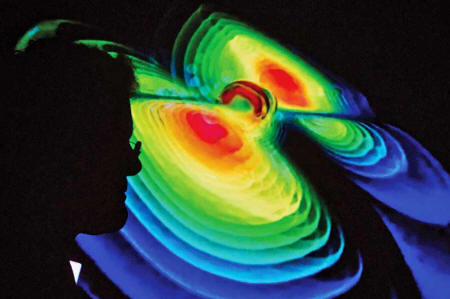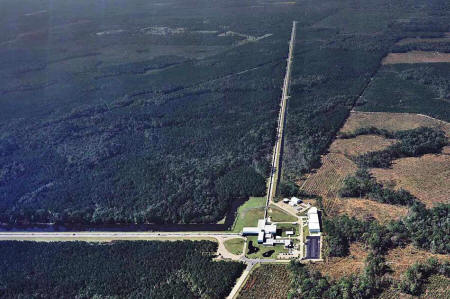|
Two black holes became one
The discovery of gravitational waves might give us a view of the cosmos that stretches all the way back to the big bang
and tell us if there's a
theory of everything
So says Erik Katsavounidis of MIT, one of the team behind the long-awaited discovery of gravitational waves.
On 11 February, the Laser Interferometer Gravitational-Wave observatory, or LIGO, announced it had spotted gravitational waves, the stretching and squeezing of space-time caused by the movement of massive objects.
The announcement caused a sensation among physicists and astronomers across the world, and they are now gearing up to exploit this new window on the universe.
Gravitational waves will allow us to explore fundamental physics, examine the weirdest objects in the universe and possibly even peer back to the universe's earliest moments.
The signal was picked up by LIGO's two observatories in Hanford, Washington, and Livingston, Louisiana, on 14 September 2015.
It was created by two black holes colliding, each about 30 times the mass of the sun. The details of the signal suggest they circled each other closer and closer until they finally merged into one. This immediately resolved one open question for astronomers. Before the signal came in, the very existence of such black hole binaries was contested.
Because they are dark, black holes of these masses are almost impossible to spot unless something bright - like a star - orbits them.
"Signals from black hole mergers could help us understand the nature of dark energy"
The next target is to observe gravitational waves from the death spiral of two neutron stars.
Unlike black holes, which hide their mass behind an event horizon even as they crash, colliding neutron stars spew hot, bright matter across space, which could help us explore other mysteries.
For example, studying these explosions may explain short gamma-ray bursts - mysterious and incredibly bright electromagnetic phenomena. They might also help explain where much of the universe's heavy elements, like uranium, thorium and gold, are forged.
Within the next two years, LIGO should be sensitive enough to detect gravitational waves from any neutron star mergers that happen within the nearest 300,000 galaxies. That means we should see about one signal per month.
These single event detections are just the start, however. Put several together and we should be able to get new insights into the history and composition of the universe as a whole, says Avi Loeb of Harvard University.
The signals from a number of black hole mergers, for example, can be combined to help understand the nature of dark energy, which is causing the universe's expansion to accelerate.
LIGO has a big reach Caltech/LIGO
From the "shape" of the signal - how the waves' frequency and volume rise and fall - we can discern the sizes of the black holes involved, and determine how loud the event was at its source.
Comparing how powerful it really was to the faint vibrations LIGO detected tells us how far away it occurred. Combined with observations from standard telescopes, this can tell us how space has expanded during the time the waves took to reach us, providing a measure of dark energy's effect on space.
This measure should be stronger and more reliable than anything we have used so far.
Spotting just a few black hole mergers would change everything, Loeb says.
Other researchers are hoping to use gravitational wave signals to put Einstein's general theory of relativity to even more stringent tests.
One way is through the equivalence principle, an assumption that gravity affects all masses in the same way.
Erminia Calabrese, an astronomer at the University of Oxford, sees gravitational waves as a way to check whether gravity behaves as relativity predicts it should over large distances.
More detectors
LIGO's success could see an explosion in gravitational wave detection.
India, for example, has long been slated to host a third LIGO detector. Funding has yet to materialize, but after last Thursday's announcement, Indian prime minister Narendra Modi tweeted that he hopes,
Other types of detectors could come on the scene, too.
New designs are already in the pipeline.
The European Space Agency is about to start tests of equipment for the Evolved Laser Interferometer Antenna (eLISA), a huge, space-based detector. A preparatory experiment, LISA Pathfinder, is in orbit and will begin tests next month. NASA pulled out of the project in 2011, but has now formed a committee to look into how it might rejoin.
Further ahead, we might see more sensitive gravitational wave detectors, working at shorter wavelengths than LIGO.
These may allow us to sense primordial gravitational waves from the very young universe. These waves should have been produced in the period of inflation - the tremendous growth spurt in the first instants after the big bang. Unlike photons and other electromagnetic radiation, they would have travelled freely through the newborn universe.
At the moment we can only see as far back as 380,000 years after the big bang, when the universe became transparent to light.
Gravitational waves may even point the way toward a grand unified theory of the universe. Theory suggests that at some point in the universe's history, all four fundamental forces were united into a single force.
As the universe expanded and cooled, the forces split off from one another in a series of as-yet poorly understood events.
For now, physicists already have a mystery to solve:
No one expected merging black holes to give off gamma rays.
LIGO team member Daniel Holz at the University of Chicago reckons this surprise is just the beginning.
|



